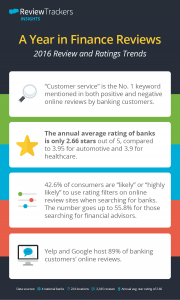Reputation is a powerful business currency in banking and financial services. But reputational crises continue to encumber firms.
In a survey by Ernst & Young, respondents said reputation was one of the most important factors in deciding whether or not to trust a financial services provider. But their expectations aren’t necessarily being met: a Gallup study revealed that U.S. consumers’ trust in banks had fallen to an all-time low, while Edelman Insights found that the financial services sector was the one industry that people trusted even less than the media sector.
Simply put: there is still a gap between consumer expectations and bank performance across a range of factors involving reputation — even as the fallout from last decade’s big banking scandals and corporate collapses has faded away.
Customer Service: the Key Experience Factor in Banking
How can companies fix this?
Well, you need not look far. The key may lie in a concept so routine and traditional that many overlook it: customer service.
According to research by customer feedback software company ReviewTrackers, “customer service” is the No. 1 keyword mentioned in online reviews posted by banking customers. It is also the top keyword associated with both the highest positive and negative sentiment scores — which suggests that, more than any other experience factor, customer service affects what customers say, think, and feel about their banks.
The research is based on a January 2017 local search and online reviews survey conducted by ReviewTrackers, as well as findings from an analysis of over 2,300 online reviews of 4 national banking firms.
In highly rated, favorable reviews, customers heaped praise on companies that delivered a positive experience through great customer service. On the other end of the spectrum, negative reviews often cited bad service as one of the main culprits behind customers’ forgettable experiences, along with “tellers” and “long lines”.

Key business takeaway: customer service and review management are difference-makers
In service-based business categories like banking and financial services, there is often little variation in product offerings. This makes customer service a powerful (and natural) competitive differentiator — and one of the most effective tactics for improving brand and business reputation.
And while a number of banks and financial services providers choose to implement corporate social responsibility (CSR) programs, green supply chains, charity campaigns, and similar initiatives in hopes of getting a reputational boost, ReviewTrackers’ findings imply that the ability to manage online reviews is crucial to improving reputation — and part of managing reviews is delivering the type of customer service worthy of 5-star ratings.
Banking and Finance Still Lagging Behind Other Industries in Ratings Game
As industries that are predicated on reputation and consumer trust in order to function, banking and financial services are, in the reputation and trust department, still lagging behind sectors like automotive and healthcare.
ReviewTrackers research found that the annual average rating of banks is only 2.66 stars out of 5, compared to 3.95 for automotive and 3.9 for healthcare.
Moreover, on YellowPages, the review website where banking customers posted the kindest reviews, the average rating of banks is only 3.5 stars out of 5. Meanwhile, MyBankTracker came out as the website where people were most hostile to their banks, posting a depressing average rating of 1.38 stars out of 5.
More than ever, banking customers are using rating filters
What makes this particularly alarming is that, now more than ever, consumers are looking beyond a bank’s digital strengths, rewards programs, and loan options — and reading online reviews and ratings in order to validate their decisions.
In fact, findings from ReviewTrackers’ survey confirmed that 42.6 percent of consumers are “likely” or “highly likely” to use rating filters on online review sites when searching for bank branches. The number goes up to 55.8 percent for those searching for financial advisors.
Reviews of banks are also 5 times more influential to consumers than TV advertisements and 6 times more influential than content found in social media posts and ads.
Beyond star ratings and satisfaction scores, online review websites also offer information that can be used to accurately measure customer experience.
One company that has learned to successfully harness reviews as a strategic tool is U.S. Bank, which actively monitors and responds to customer feedback posted on online review sites.
“We’re proactive in looking for a view of every source of customer feedback we can get, and leveraging it to make our products and services better,” says Troy Janisch, vice president/director of social intelligence for U.S. Bank. “If you’re not looking at the content that customers are delivering to review sites, you’re not getting the full picture.”



